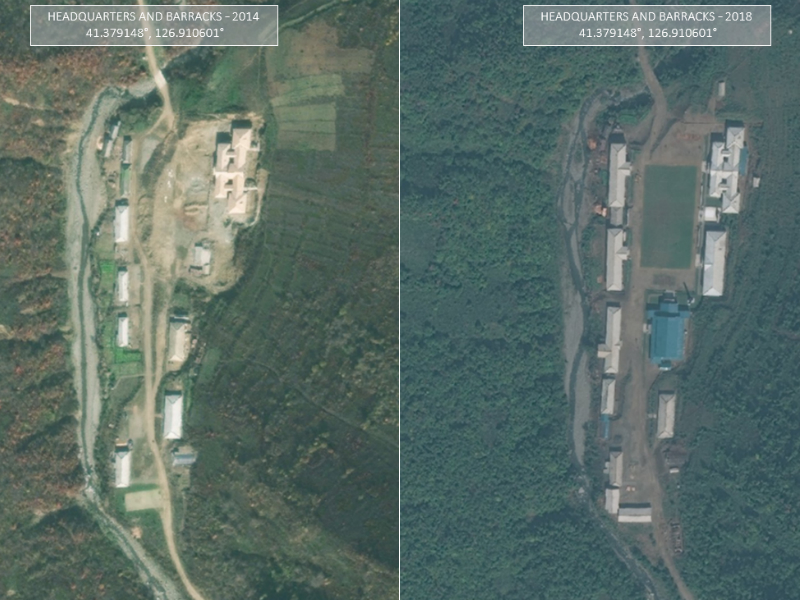When U.S. President Donald Trump and North Korean leader Kim Jong Un met for their historic Singapore summit in July, the pair emerged with a joint statement in which the latter reaffirmed a commitment to “complete denuclearization of the Korean Peninsula.”

Months later, satellites over North Korea spotted evidence of expansion at two sites that experts have called ideal places for the storage of intercontinental ballistic missiles (ICBMs).
Coverage of North Korea on Globalnews.ca:
That’s according to a report out of the Centre for Nonproliferation Studies (CNS) at Middlebury Institute of International Studies at Monterey in California.
Published Thursday, the report used satellite imagery from Planet Labs and high-resolution imagery from Digital Globe to analyze how much two particular sites have expanded in recent years.
READ MORE: Trump believes North Korea is moving to denuclearization. But its activities haven’t stopped — IAEA
The sites are the Yeongjeo-dong missile base and a separate, previously-undisclosed location near an area known as Hoejung-ni.
Images taken at Yeongjeo-dong show evidence of camouflaging, suggesting that they were taken during construction or right after, the report said.
The authors pointed out that the base was located along a narrow valley and that a headquarters was built at its mouth.
They also noted two “drive-through” shelters that had been covered with soil and that had trees planted atop them.
This slider image shows drive-through shelters at Yeongjeo-dong missile base in 2004 and 2013:
The trees were ostensibly planted there in an effort to conceal them.
Satellite imagery also showed a concrete pad at the site that was covered with dirt.

Get daily National news
“The camouflage is pretty effective,” the report said.
Images also caught five entrances to tunnels that, the authors said, could be used for missile storage.
This slider image shows the tunnels in 2004 and 2013:
Yeongjeo-dong has been known since at least November 1998 — and accessing it has been a challenge.
The Washington Post reported on how North Korea was building a new base to house its Taepodong missiles, which are believed to have a range of as much as 10,000 kilometres with a payload of 1,000 kilograms.
Former secretary of state Madeline Albright discussed the site amid talks with North Korea in October 2000. As Albright spoke with then-leader Kim Jong Il, she said his son, now-leader Kim Jong Un, wouldn’t allow any access to the site, saying, “you can’t go inside the units and inspect them.”
WATCH: Trump says he fell in love with North Korean leader Kim Jong Un

Less known is a separate site located about 11 kilometres away, close to an area known as Hoejung-ni.
That base also showed evidence of camouflaging around drive-through shelters that were “suitable for large ballistic missiles,” the report said.
This slider image shows the shelters at the base near Hoejung-ni in 2010 and 2018:
The researchers also found evidence of expansion at this base, with imagery capturing evidence of a headquarters being built in 2014.
The way the buildings were arranged was similar to how they were laid out at Yeongjeo-dong.
There was also evidence of the building of an underground facility, which appeared to have started in 2017.
It’s still being built, the report said.
What makes these sites so optimal for missiles is their location inland, close to the Chinese border, co-author and research associate Dave Schermer told Global News.
Shorter-range missiles, he said, are likely to be stationed closer to the demilitarized zone (DMZ), while medium-range missiles would be located in the middle of the country.
Meanwhile, the “back end” of the country close to the Chinese border is a strong place for missiles because “strategically and tactically it’s harder to strike,” Schermer said.
“It throws an extra level of complication in the decision and process in which you would think about attacking these sites,” he added.
“Whereas sites closer to the border, maybe in the middle of the country are optimal, because if you’ve initiated that type of conflict, you will gain easy access so you can take out air defense and things like that.”
The images come just under a month after the Center for Strategic and International Studies reported that 13 out of an estimated 20 undeclared North Korean missile operating bases had been located.
These bases can be used for all kinds of ballistic missiles, it said, from short-range weapons to ICBMs.
An operating facility isn’t a place from which missiles would be launched, the centre said.
WATCH: Trump admin continues to insist that progress with North Korea ‘tremendous’

Nevertheless, they would likely have to be declared and dismantled in any deal to denuclearize the peninsula.
The latest imagery suggests that North Korea isn’t exactly moving in the direction of denuclearization — but Schermer doesn’t think the Trump administration was fooled by North Korea’s statements at the Singapore summit.
“I think during the summit they agreed notionally to work toward a better world where these countries wouldn’t need these weapons like almost every nuclear weapons state does,” he said.
“But I don’t think they said, in a year, we will close down everything.”














Comments